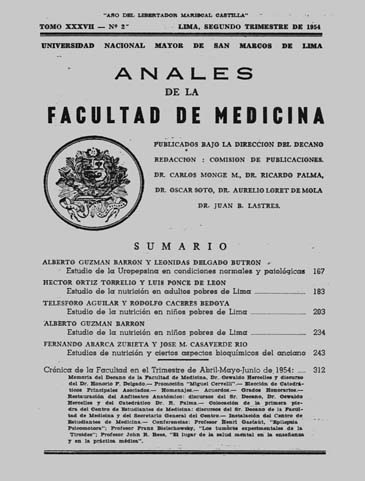Study of nutrition in poor children in Lima - Part Two
DOI:
https://doi.org/10.15381/anales.v37i2.9441Abstract
Earlier in this volume Aguilar and Caceres studied from the point of view, chemical and biochemical 100 poor children in Lima, 6 to 14 years old. This paper deals with the study of inorganic phosphorus and alkaline phosphatase in the same children, in order to get an idea of deficiency states of vitamin D, calcium and phosphorus. The average number of inorganic phosphorus is mgrs. 4.78%, 8.76 units of alkaline phosphatase Bodansky, both figures are averages considered normal for children ages indicated. In no case has been found by clinical examination or determination of phosphatases signs of rickets, although the food they receive is poor in calcium. This may be because the subjects studied in school almost entirely properly receive the action of the sun, allowing them to synthesize adequate amounts of vitamin D, which will bring a good use of the little calcium in your diet. These results agree with those made by other researchers in tropical regions.Downloads
Published
1954-06-14
Issue
Section
Trabajos originales
License
Copyright (c) 1954 Alberto Guzmán Barrón

This work is licensed under a Creative Commons Attribution-NonCommercial-ShareAlike 4.0 International License.
Those authors who have publications with this magazine accept the following terms:
- Authors will retain their copyrights and guarantee the journal the right of first publication of their work, which will be simultaneously subject to Creative Commons Attribution License that allows third parties to share the work as long as its author and its first publication this magazine are indicated.
- Authors may adopt other non-exclusive licensing agreements for the distribution of the version of the published work (eg, deposit it in an institutional electronic file or publish it in a monographic volume) provided that the initial publication in this magazine is indicated.
- Authors are allowed and recommended to disseminate their work over the Internet (eg: in institutional telematic archives or on their website) before and during the submission process, which It can produce interesting exchanges and increase quotes from the published work. (See El efecto del acceso abierto ).
How to Cite
1.
Guzmán Barrón A. Study of nutrition in poor children in Lima - Part Two. An Fac med [Internet]. 1954 Jun. 14 [cited 2024 Jul. 17];37(2):234-42. Available from: https://revistasinvestigacion.unmsm.edu.pe/index.php/anales/article/view/9441















